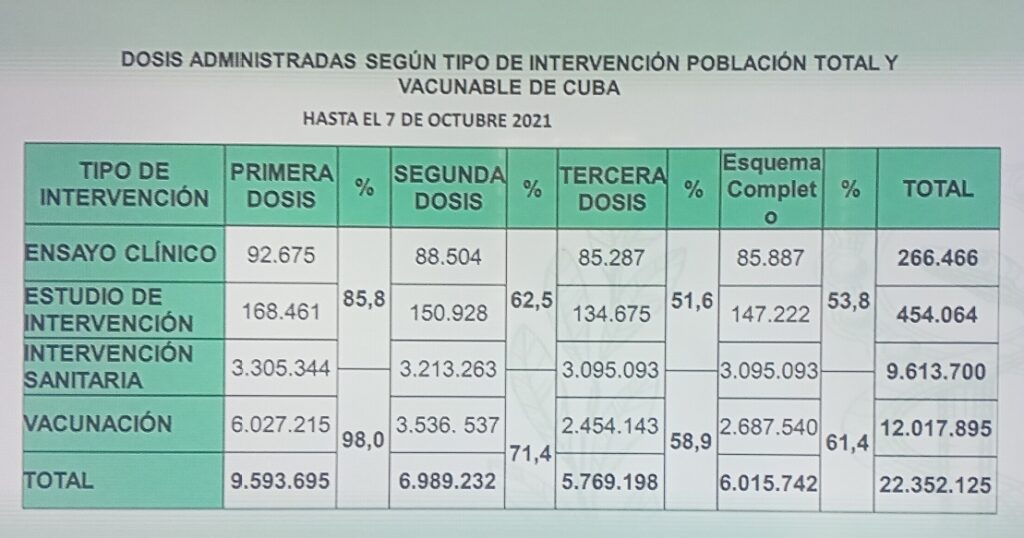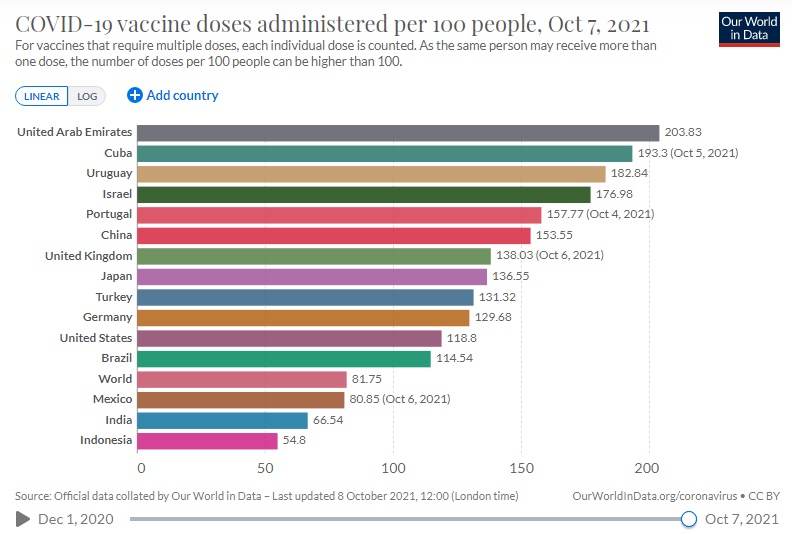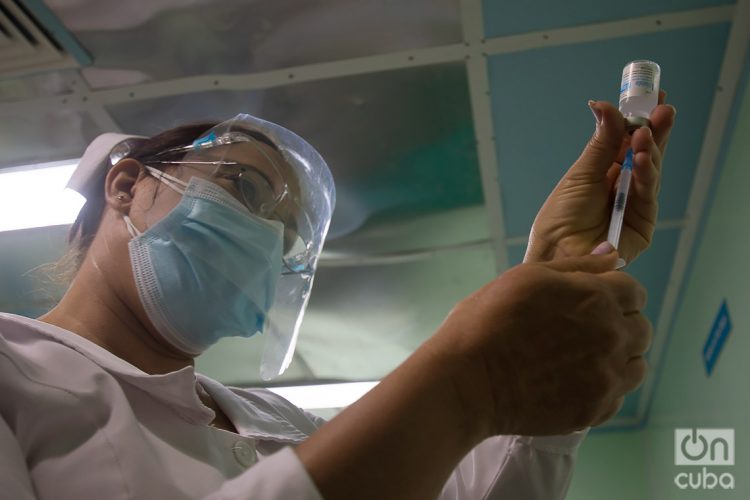With less than three months for the end of 2021, the progress of vaccination in Cuba is undeniable, although not without difficulties and questions, triumphalism and information gaps.
by Eric CaraballosoOctober 11, 2021in Coronavirus
With less than three months for the end of 2021, the progress of COVID-19 vaccination in Cuba is undeniable. Although not without difficulties and questions, triumphalism and information gaps, this process, developed almost entirely with the island’s own drugs, is going smoothly today and its effects seem to be already noticeable in the daily statistics of the pandemic on the country.
Immunization against COVID-19 took a notable boost last September, after initial forecasts for August fell below expectations. In this “acceleration,” not only a greater availability of doses and the expansion of the process has had an impact on all Cuban municipalities, but also the beginning of mass vaccination in pediatric ages ― which in Cuba ranges from two and 18 years of age ―, as well as those allergic to thimerosal and convalescents from the disease, after the corresponding approvals by the national regulatory authority.
Thus, as of October 7, more than 22 million vaccine doses had been administered on the island, according to the Ministry of Public Health (MINSAP). In addition, more than 9 million people — 85.8% of the Cuban population — had received at least the first dose, and more than 6 million — 53.8% — had completed the vaccination scheme. These same figures represent 98% and 61.4%, respectively, of the “vaccinable population,” a concept currently used by health authorities that excludes from the calculation those people who, for different reasons, cannot be immunized for the time being.

As for minors, up to October 3, more than 1.731 million children and adolescents had received at least one dose, which was equivalent to 95.8% of those who could be vaccinated, according to data shared by Cuban Foreign Minister Bruno Rodríguez on his Twitter profile.
In this way, Cuba is on track to meet its goal of immunizing its entire population this year — at least, the one that is in a position to be vaccinated and also willing to do so — and to exceed 90% in November, when the authorities plan to increase air operations and international tourism, and “make more flexible” sanitary protocols at the border. In addition, these figures place the island — which has already begun a gradual and differentiated de-escalation in search of economic reactivation — among the leading nations in the world in various COVID-19 vaccination indicators.
According to the Our World in Data website, which collects global immunization statistics based on official data from each country, Cuba is currently at the forefront in terms of the percentage of vaccinated, daily doses administered per 100 people — where up to October 5 it marched as the leader with 1.37 and reached 2.84 on September 23 —, and in general, throughout the pandemic, as well as the percentage of people who had received at least one dose of an injectable against COVID-19, as evidenced by the graphs we share below.

This scenario has been possible, to a large extent, due to the experience and structure of the Cuban state health system, which for decades has carried out vaccination campaigns against different diseases, even when they have not been of the current intensity and scope. Such training and organization now allowed it to launch an immunization strategy that, at its peak of administration, exceeded 350,000 daily doses and averaged over 200,000 last September, as confirmed at the end of that month by Dr. Ileana Morales, MINSAP director of science and innovation.
The official then explained on the Mesa Redonda television program that the strategy applied in the country is “universal, gradual and intensive,” supported by the potentialities of the Cuban biopharmaceutical industry and “very consistent with the regulatory and ethical components involved in the development of vaccines.” This gradual process made it possible to go from clinical trials to interventions in risk groups and territories — based on the “overwhelming evidence” about the safety and efficacy of the vaccine candidates at that time — and from this to mass vaccination, when the emergency use authorization was finally granted.
“Under normal conditions, it would have taken years. From the trials to the approval of the intervention study, to mass vaccination, it takes two, three, four months, as is the time that we have taken since the intervention began, on May 10,” recalled Dr. Morales, who acknowledged that this process “has been a very big challenge which the industry and also the population have had to face” and said that everything has been done “in real time,” “with intense management so that the established schemes are met without violating anything.”
The value of its own vaccines
All of the above is due, in the first place, to Cuba’s commitment to creating its own COVID-19 vaccines. From the very beginning of the pandemic, Cuban authorities and scientists set themselves that objective, based on the expertise and recognized development of the Cuban biotechnology sector, and with a view to achieving sovereignty in this field which would enable the country to not depend on foreign products to immunize the population and even convert future immunogens into a promising source of income through their export.
Following this compass, and after a necessary and accelerated process of study and decantation, Cuban science had in a few months five vaccine candidates, which gradually began clinical trials and demonstrated their successes against SARS-CoV-2 and its different variants. Of these, Abdala, developed by the Center for Genetic Engineering and Biotechnology (CIGB), and Soberana 02 and Soberana Plus, by the Finlay Vaccine Institute (IFV), would become the first COVID-19 vaccines in Latin America, with high levels of safety, immunogenicity and efficacy, according to official data, while Soberana 01 and Mambisa continue to be studied and remain on the path of emulating the most advanced vaccines.
At the same time, the Cuban authorities chose not to participate in the COVAX mechanism, promoted by the World Health Organization (WHO) and which aims to guarantee equitable access to COVID-19 vaccines among different countries. Such a decision has been harshly criticized by some experts and detractors of the government, which, in turn, has defended itself with the argument that being part of COVAX or acquiring foreign immunogens outside of this platform would have implied additional expenses for the country in a moment of severe economic crisis and it would not have guaranteed the vaccination coverage that in a shorter time its ow drugs should allow, and which in the end they are allowing.
So, beyond this controversy and its political and economic backdrop, having national vaccines has turned out to be the main asset of immunization on the island. And although some difficulties with the advancement of research and productive escalation ― due, among other causes, to problems in accessing necessary products and technologies, as a result of the U.S. embargo — delayed initial forecasts and generated doubts and questions inside and outside of Cuba, at a time when the country was going through its worst peak of the entire pandemic, the momentum achieved in recent weeks has ended up supporting the Cuban bet.
Minsap: todos los diagnosticados con la COVID-19 serán vacunados
It is true that the alleged purpose of immunizing only with Cuban injectables collapsed with the use of the Chinese Sinopharm vaccine in several provinces, such as Cienfuegos, Villa Clara and Sancti Spíritus, territories that had not started the process and in those allergic to thimerosal. But the fact that this is combined with a final dose of Soberana Plus maintains the presence of national immunogens in all the schemes applied in the country, while also contributing to accelerate vaccination and recover time in order to close the year with all possible population already immunized. This is also due to the fact that all the doses necessary to complete the process have already been produced in the country, as announced days ago by the BioCubaFarma business group.
The march towards that objective — which is, in short, the greater good sought by authorities and specialists, and which should contribute significantly to the control of COVID-19 on the island — even though it has been and continues to be questioned by some, has also been highlighted by experts, organizations and international media, in a global context marked by an unequal distribution of vaccines. Even U.S. publications such as The New York Times and Newsweek have pondered the Cuban immunization strategy with its own drugs, despite the negative impact of the economic crisis and Washington’s sanctions.
In an article published just a few days ago, Newsweek also turned its gaze to the resistance to COVID-19 vaccines that exists in many countries, including the United States itself, a situation that has barely penetrated Cuba. In its comparison, it cites statements by Carlos Fernández de Cossío, director for the United States of the Cuban Foreign Ministry, who highlighted that “people in Cuba are eager and motivated to get vaccinated” and points out that the island does not have “the cultural problem that seems to exist.” in the North American nation. And although generalizations always carry the risk of being inaccurate, the truth is that the Cuban population has massively supported immunization — an issue that undoubtedly deserves a separate work for its analysis — which has facilitated the rapid advance of this process once the necessary conditions were in place for its large-scale implementation.
And while this is happening, the island has already begun to export its immunogens and to establish agreements and contacts for this purpose with various countries. Traditional allies such as Vietnam, Venezuela and Nicaragua are at the top of a list that could grow in the coming weeks and months given the well-known interest of other countries — mainly from Latin America, the Caribbean and Africa — in Cuban vaccines, as an alternative or complement to those offered by COVAX, pharmaceutical companies such as Pfizer and Moderna and powers such as Russia and China. And, at the same time, Cuba began exchanges with the WHO, with a view to receiving an endorsement from the entity that would mean an important boost to Cuban vaccines and could open new doors for their commercialization.
Cuba presents results of its COVID-19 vaccines to WHO experts
The chiaroscuros of statistics
However, beyond its undeniable achievements and highlights, the vaccination against COVID in Cuba also has its shadows and chiaroscuros. Some logistical and organizational problems have hampered it in various moments and territories, even though the official media have not been very keen to point them out and these difficulties are certainly not enough to cloud the overall result. In this sense, the scale and complexity of a campaign such as the one being carried out cannot be lost sight of, nor the fact that it has been taking place alongside the worst wave of COVID-19 on the island, which has multiplied the tensions on a health system that, even with its structure and previous experience, is certainly far from perfect.
More controversial is the issue of statistics, an aspect that has led to the government being questioned throughout the pandemic and which, although not totally, also extends to the immunization process. Because, although the island’s authorities ― and, in particular, the MINSAP ― issue daily reports on infections, deaths, active cases, administered doses and vaccinated people, among other indicators, there are not a few who, inside and outside of Cuba ― either for political reasons, distrust of what is official or due to analysis and personal experiences that, they claim, contradict what has been reported ―, disbelieve such figures and attribute them to a biased and propagandistic handling of the confrontation with COVID-19.
Cuban vaccines, in particular, have been the systematic target of criticism, mainly from sectors and media opposed to the government and based abroad, which have questioned or even denied their quality and the efficacy data officially reported, in all cases above 90% in clinical trials. However, even when there is a politically motivated campaign against the government’s management of the pandemic and, in particular, against the immunogens developed on the island — as the authorities themselves maintain — not all questions and concerns should be understood as part of that campaign and could well be answered with a more open and detailed handling of the statistics, which helps to balance the triumphalist tone of many official data.
Cuban specialists have emphasized the difference between efficacy, calculated in controlled studies and with inclusion criteria, and the effectiveness of vaccines in the field, where the massiveness of the process and other variables, such as the simultaneity of vaccination with the pandemic peak caused by the Delta variant, require a greater moderation and analytical perspective when interpreting the figures. In addition, they have commented on the complexity involved in collecting and processing data related to the effectiveness of immunization in an epidemiological scenario as complex as that experienced by the island in recent months. This is undoubtedly understandable.
However, even recognizing the foregoing, given the time that has elapsed since the beginning of this process ― at least, in the most advanced territories ―, it is not difficult to suppose that Cuban specialists and authorities already have in their possession more figures than those made public up to now, both on the indicators analyzed and on the statistical base that allows calculating said indicators. On the other hand, and unlike the daily course of vaccination, the effectiveness data have been reported so far drop by drop, without specifying all the elements that allowed their calculation and offering a more comprehensive and contrasting panorama. And this, far from objectively counteracting the questions and suspicions, generates new and legitimate questions and provides fuel for the staunchest and most radical critics.
BioCubaFarma denounces fake news related to Cuban Abdala vaccine
As commented last Tuesday by Dr. Pedro Más Bermejo, vice president of the Cuban Society of Hygiene and Epidemiology, in a meeting between scientists and authorities, a study in people with 14 and up to 28 days of vaccination in Havana, carried out between last July 11 and August 31, confirmed an effectiveness of the Abdala vaccine of 90.9% four weeks after the start of immunization, and 93.6% on the eighth week, in the seven Havana municipalities where the immunization started first. Regarding the effectiveness to avoid serious forms and death, this was 92% and 90.7%, respectively.
Dr. Más Bermejo explained that “the evaluation was based on individuals admitted to seriously ill patient care units and on deceased individuals who were confirmed with PCR or antigen test, 19 years of age or older and residents of the capital,” according to the Cubadebate website. However, the official information — at least that published in the meeting’s review — does not specify the number of people who were considered for the study or how many of them went to intensive care and died, data that would complement what was reported and would contribute to a fuller understanding of the evaluated process.
Previously, in the report of meetings like this one or in official informational spaces such as the Mesa Redonda, some other information has been given, but generally in a specific and spaced way. For example, in mid-August, when immunization still did not have the momentum or coverage that it would reach shortly thereafter, Dr. Ileana Morales acknowledged that the country registered at least 119 deaths of people already vaccinated, which represented 0.004% of the total immunized on the island at that time. In addition, the figure itself implied a 46% fatality rate among the 25,608 patients who had been infected with SARS-CoV-2 until then after receiving a Cuban drug. However, these figures, enlightening when assessing the impact of vaccination, have not been publicly updated again, much less stratified by territories, sex, age groups, comorbidities and other variables to further enrich the analysis.
Leaving such chiaroscuros behind with broader and more up-to-date information would then contribute to providing more transparency about the advanced immunization process in Cuba — while other important data are processed, such as those on the decrease of antibodies over time — and to respond with the objectivity of the numbers to the criticisms and questioning, well-intentioned or not, about the communicative management of the pandemic. At a time when negative COVID-19 statistics begin to decline in official reports, even though the incidence of the disease remains high in several territories and the number of daily diagnostic tests has decreased compared to weeks ago, publicly confirming the effectiveness of vaccines with the greatest amount of data to support it would undoubtedly be an added value that, even already with our three doses, many of us would appreciate.

